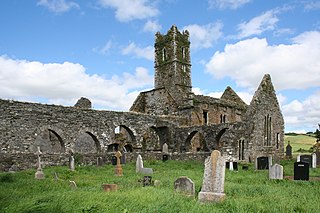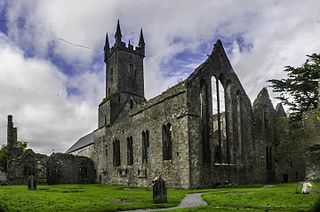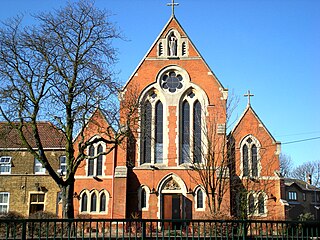
Kildare is a town in County Kildare, Ireland. As of 2022, its population was 10,302, making it the 7th largest town in County Kildare. It is home to Kildare Cathedral, historically the site of an important abbey said to have been founded by Saint Brigid of Kildare in the 5th century. The Curragh lies east of the town.

Timoleague Friary, also known as Timoleague Abbey, is a ruined medieval Franciscan friary in Timoleague, County Cork, Ireland, on the banks of the Argideen River overlooking Courtmacsherry Bay. It was built on the site of an early Christian monastic site founded by Saint Molaga, from whom the town of Timoleague derives its name. The present remains date from roughly the turn of the fourteenth century and were burnt down by British forces in the mid-seventeenth century, at which point it was an important ecclesiastical centre that engaged in significant trade with Spain.

Muckross Abbey is one of the major ecclesiastical sites, found in the Killarney National Park, County Kerry, Ireland. It was founded in 1448 as a Franciscan friary for the Observantine Franciscans by Donal McCarthy Mor.

Sir John de Courcy (1150–1219) was an Anglo-Norman knight who arrived in Ireland in 1176. From then until his expulsion in 1204, he conquered a considerable territory, endowed religious establishments, built abbeys for both the Benedictines and the Cistercians and built strongholds at Dundrum Castle in County Down and Carrickfergus Castle in County Antrim.

The Buttevant Franciscan Friary is a ruined 13th-century Franciscan friary is situated in the middle of the town of Buttevant, County Cork, Ireland. The Augustinian friary in nearby Ballybeg is often confused with the Buttevant Franciscan Friary in historical documents.

Quin Abbey, is a ruined Franciscan abbey in Quin, County Clare, Ireland. It was built for Fathers Purcell and Mooney, friars of the Franciscan order.

Greyfriars Church is an evangelical Anglican church, and former Franciscan friary, in the town centre of Reading in the English county of Berkshire. The church forms part of the Church of England's Diocese of Oxford.

The Claregalway Friary is a ruined medieval Franciscan abbey in Claregalway, County Galway, Ireland.

Multyfarnham or Multyfarnam is a village in County Westmeath, Ireland. As of the 2022 census, it had a population of 460 people.

Canon Island Abbey is a ruined Augustinian monastery located on the extreme northeast corner of Canon Island (Inisgad) on the River Shannon in County Clare, Ireland.

St Augustine's Abbey or Chilworth Abbey, formerly Chilworth Friary, is a Roman Catholic Benedictine abbey in Chilworth, Surrey. The building, which is Grade II listed, was designed by Frederick Walters and was built in 1892. It was formerly a Franciscan friary and a novitiate for the order. The abbey church is open to the public 365 days a year.

Ennis Friary was a Franciscan friary in the town of Ennis, County Clare, Ireland. It was established in the middle of the 13th century by the ruling O'Brien dynasty who supported it for most of its existence. Following the suppression of the monasteries in the 16th century, the friary continued to function for a while despite the loss of its lands. In the early 17th century, the buildings were handed over to the Church of Ireland as a place of worship. It was used as such until the late 19th century. After the construction of a new Church of Ireland building, the friary fell into ruin. Managed by the Office of Public Works since the late 19th century, it was formally returned to the Franciscan Order in 1969.

Ardfert Abbey, also known as Ardfert Friary, is a ruined medieval Franciscan friary and National Monument in Ardfert, County Kerry, Ireland. It is thought to be built on the site of an early Christian monastic site founded by Brendan the Navigator. The present remains date from the mid-thirteenth century, with the residential tower being added in the 15th century. The friary was dissolved in 1584.

Askeaton Abbey or Askeaton Friary is a ruined medieval Franciscan friary located north of Askeaton, County Limerick, Ireland, on the east bank of the River Deel.

William Percival "Percy" Le Clerc was Inspector of National Monuments in Ireland from 1949 to 1974, making him responsible for the preservation of buildings already classified as National Monuments. He also made decisions on which further buildings in Ireland should be brought into state ownership or guardianship. He was a founding member of the Irish Georgian Society.

St Thomas of Canterbury Church is a Roman Catholic parish church in Woodford Green, Woodford, London. It was built from 1895 to 1896, was designed by Alexander Scoles and has been served by the Franciscan Order of Friars Minor since its foundation. It is located on Woodford Green road next to Trinity Catholic High School. It was funded by Henrietta Pelham-Clinton, Duchess of Newcastle, who also paid for the friary, a primary school, a school for girls, a house for the Poor Servants of the Mother of God, and is buried in the church.

















